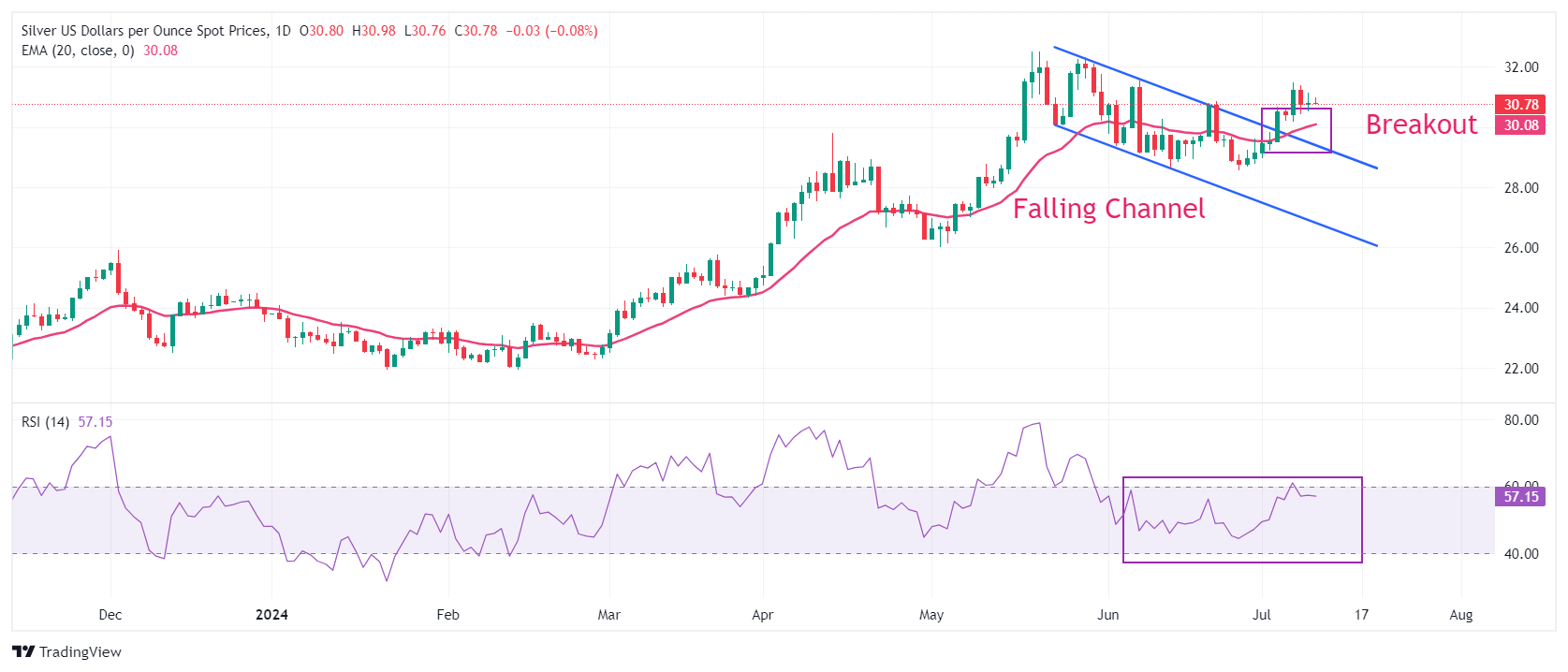- Analytics
- News and Tools
- Market News
- Silver Price Forecast: XAG/USD stays in a tight range around $31 with US Inflation in focus
Silver Price Forecast: XAG/USD stays in a tight range around $31 with US Inflation in focus
- Silver price trades sideways around $31.00 as investors await the US Inflation report for June.
- Fed Powell signaled that the labor market strength appears to be easing.
- Silver price holds the Falling Channel breakout.
Silver price (XAG/USD) trades sideways near $31.00 in Wednesday’s Asian session. The white metal consolidates even though the commentary from Federal Reserve (Fed) Chair Jerome Powell, in his semi-annual Congressional testimony on Wednesday, indicated that risks to the Fed’s dual mandate are finely balanced.
Fed Powell acknowledged that labor market conditions are no tighter enough that was experienced after mammoth liquidity infusion in pandemic era. On inflation, Powell commented that the Fed has made some progress in inflation in recent months and more good data would bolster the case for looser monetary policy, Reuters reported.
However, Powell still not delivered any timeframe for rate cuts but his commentary has kept strength in market expectations for the Fed to begin reducing interest rates from September intact.
Meanwhile, the US Dollar (USD) has remained under pressure ahead of the United States (US) Consumer Price Index (CPI) report for June, which will be published on Thursday. The US Dollar Index (DXY), which tracks the Greenback’s value against six major currencies, gains ground above the almost four-week low of 104.85.10-year US Treasury yields and consolidates around 4.30%.
Silver technical analysis
Silver price extends its upside to near $31.00 after a breakout of the Falling Channel formation on a four-hour timeframe. An upside break of the above-mentioned chart pattern results in a bullish reversal. Upward-sloping 20-day Exponential Moving Average (EMA) at $30.70, exhibits a bullish trend.
The 14-period Relative Strength Index (RSI) shifts into the bullish range of 60.00-80.00, indicating that momentum has shifted to the upside.
Silver four-hour chart
Silver FAQs
Silver is a precious metal highly traded among investors. It has been historically used as a store of value and a medium of exchange. Although less popular than Gold, traders may turn to Silver to diversify their investment portfolio, for its intrinsic value or as a potential hedge during high-inflation periods. Investors can buy physical Silver, in coins or in bars, or trade it through vehicles such as Exchange Traded Funds, which track its price on international markets.
Silver prices can move due to a wide range of factors. Geopolitical instability or fears of a deep recession can make Silver price escalate due to its safe-haven status, although to a lesser extent than Gold's. As a yieldless asset, Silver tends to rise with lower interest rates. Its moves also depend on how the US Dollar (USD) behaves as the asset is priced in dollars (XAG/USD). A strong Dollar tends to keep the price of Silver at bay, whereas a weaker Dollar is likely to propel prices up. Other factors such as investment demand, mining supply – Silver is much more abundant than Gold – and recycling rates can also affect prices.
Silver is widely used in industry, particularly in sectors such as electronics or solar energy, as it has one of the highest electric conductivity of all metals – more than Copper and Gold. A surge in demand can increase prices, while a decline tends to lower them. Dynamics in the US, Chinese and Indian economies can also contribute to price swings: for the US and particularly China, their big industrial sectors use Silver in various processes; in India, consumers’ demand for the precious metal for jewellery also plays a key role in setting prices.
Silver prices tend to follow Gold's moves. When Gold prices rise, Silver typically follows suit, as their status as safe-haven assets is similar. The Gold/Silver ratio, which shows the number of ounces of Silver needed to equal the value of one ounce of Gold, may help to determine the relative valuation between both metals. Some investors may consider a high ratio as an indicator that Silver is undervalued, or Gold is overvalued. On the contrary, a low ratio might suggest that Gold is undervalued relative to Silver.
© 2000-2025. All rights reserved.
This site is managed by Teletrade D.J. LLC 2351 LLC 2022 (Euro House, Richmond Hill Road, Kingstown, VC0100, St. Vincent and the Grenadines).
The information on this website is for informational purposes only and does not constitute any investment advice.
The company does not serve or provide services to customers who are residents of the US, Canada, Iran, The Democratic People's Republic of Korea, Yemen and FATF blacklisted countries.
Making transactions on financial markets with marginal financial instruments opens up wide possibilities and allows investors who are willing to take risks to earn high profits, carrying a potentially high risk of losses at the same time. Therefore you should responsibly approach the issue of choosing the appropriate investment strategy, taking the available resources into account, before starting trading.
Use of the information: full or partial use of materials from this website must always be referenced to TeleTrade as the source of information. Use of the materials on the Internet must be accompanied by a hyperlink to teletrade.org. Automatic import of materials and information from this website is prohibited.
Please contact our PR department if you have any questions or need assistance at pr@teletrade.global.
















